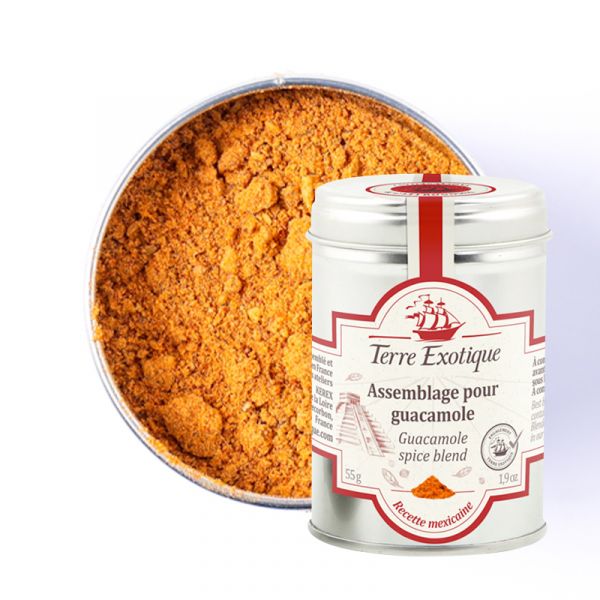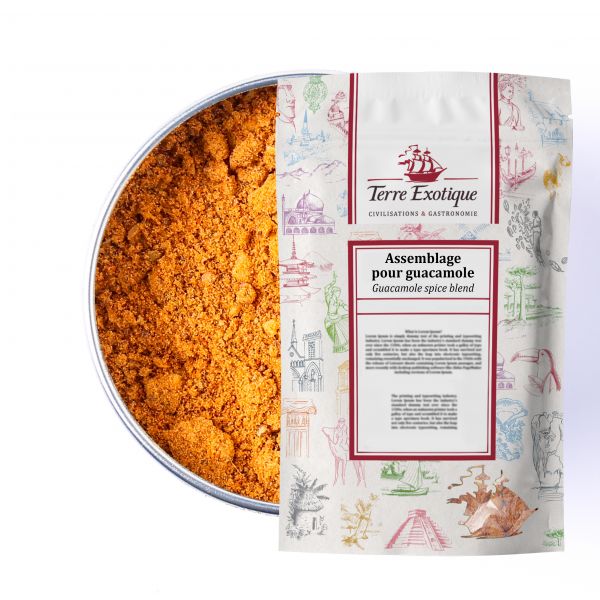





What dishes can you use the Guacamole blend for?
Like a true culinary aid, the Guacamole blend is a classic to have in your kitchen. As with any thematic blend, it is of course essential for making the recipe for the famous guacamole from which it takes its name.But being so easy to use, this ready-to-use blend can also be sprinkled wherever you like!
Moisture can cause the product to clump together, without altering its organoleptic qualities.
How to use the Guacamole blend?
Our recipe ideas for using the Guacamole blend in your cooking:- Guacamole: click here to discover the complete recipe
- Mexican vegetable stir-fry: sprinkle 1 teaspoon of Guacamole blend on your vegetables during cooking;
- Tomato soup: before blending your tomatoes, add 1 teaspoon of Guacamole blend;
- Mexican fajitas: sprinkle 1 teaspoon of Guacamole blend on your chicken during cooking.
- Salmon avocado salad in Guacamole style: click here to discover the complete recipe
The flavors of the Guacamole blend
The Guacamole blend takes you directly to the heart of Mexico with its notes that are both sweet and spicy thanks to the presence of Espelette pepper and paprika. This blend is perfectly faithful to the aromas of real Mexican guacamole.
What is in our Guacamole blend?
Our Guacamole blend is composed of onion, paprika, cumin, salt, garlic, coriander, and cayenne pepper.
The botany of the guacamole mix
Garlic, whose botanical name is Allium sativum, comes from the family Liliaceae. This perennial plant is composed of a bulb made up of cloves enclosed in membranes. Garlic can reach up to one meter in height.
Cayenne pepper is one of the most powerful peppers in the world. Also called Pili-pili, this red pepper is harvested in Uganda, the "pearl of Africa".
Its scientific name is Capsicum frutescens and belongs to the family Solanaceae, like paprika. It is also grown in Madagascar, Congo, and Zanzibar.
The paprika in this mix comes from the region of Zitava in Slovakia. Its botanical name is Capsicum annuum and belongs to the family Solanaceae, just like peppers and chili peppers. It has been traditionally cultivated in Slovakia for over 100 years. Paprika, also known as sweet pepper, is native to Colombia and the southern United States.
Coriander, Coriandrum sativum, is a plant in the Apiaceae family. Coriander is an aromatic plant that grows in various areas and is used in numerous culinary preparations, especially in Asia, Latin America, and Mediterranean cuisine.
Cumin, with the botanical name Cuminum cyminum, comes from the Apiaceae family, just like parsley. Originating from the Middle East, it is mainly cultivated in the Mediterranean basin. Cumin was initially a spice for smoking or used to prepare dishes.
The plant is about 30 cm high. The seeds are harvested when they mature, in September or October. After harvesting, the stems are dried in the sun for two to three days and then beaten to separate the seeds, which are the famous cumin we know. To obtain our cumin powder, the seeds are ground after drying for simple and flavorful use in cooking.
The history of guacamole
Guacamole is a dish of Mexican origin. The composition of this dish is itself inscribed on the UNESCO Intangible Cultural Heritage list since 2010.Guacamole is emblematic of this colorful and flavorful cuisine. Legend has it that it was the god Quetzacoatl who offered the recipe to the Toltec people. Historically, guacamole was prepared by men in a large mortar, the molcajete. Guacamole is the symbol of the marriage of Aztec and Spanish cultures. Each region, each city, each family has its traditional version.
The composition planned by UNESCO is made up of avocado, chili pepper, coriander, onions, tomatoes, lime juice, and salt. With our guacamole mix, you have the basic ingredients that make up this delicious Mexican dish, so get cooking!
| Allergen | Sulfites / Sulphites |
|---|---|
| Native country | FRANCE |
| Ingredients | onion (EU / non EU), paprika, cumin, salt, garlic (SULFITES), |
| coriander, Cayenne chilli. | |
| TRACES EVENTUELLES D'ALLERGÈNES | céleri, sésame, moutarde, fruits à coques. |
 Français
Français 